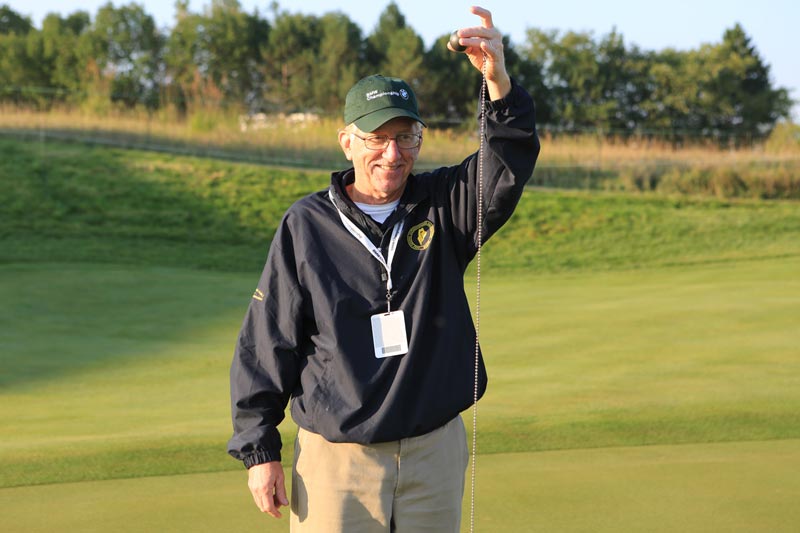
In the early days of firmness testing, a steel ball was dropped from about head height onto a putting surface, and the depth of the resulting indentation was measured. Photos courtesy of Luke Cella
Editor’s note: This article was originally published in the October 2018 issue of On Course, the monthly publication of the Midwest Association of Golf Course Superintendents.
We live in a data-driven world, and the decisions you make on the golf course are not immune to this influence. How do you sift through all the data produced and collected every day from your golf course and use it to make sound decisions?
I recently took part in a meeting where superintendents were discussing their decision-making process when it comes to applying plant protectants. This made me think of some of the tools available to superintendents that enable them to collect data. Whether it be chemical use, green speeds or labor expenses, superintendents are constantly putting numbers to their efforts.
Growing degree days
In 1969, a method to estimate heat accumulation by determining daily maximum and minimum temperatures using a sine curve to approximate the diurnal temperature curve was first published. It underwent several iterations, and in 1983, the concept took hold. Researchers Lloyd Wilson and William Barnett of the University of California stated in the opening paragraph of their 1983 research article on degree days, “Questions such as when to plant, whether the crop is developing on time, and when to initiate set control actions are particularly difficult to answer, because the timing it not always the same each year.”
Most superintendents are astutely aware of growing degree days and use them for scheduling applications of plant protectants (including growth regulators for seedhead suppression), some early-spring fungicides and certain insecticides. There are numerous growing degree day calculators out there, and no matter which calculator or model one uses, all of them state in one form or another, “When it comes to growing degree day models, it is important to remember that although they serve as useful guides, they don’t replace scouting techniques or your own observations” (GreenCast, Syngenta).
Soil moisture
The concept of the soil moisture meter has been around since the 1920s, but the development of the system we use today didn’t really happen until the 1960s. In a patent application from 1964, inventor Charles Matlin explained:
“The electrical resistivity of soil is primarily a function of soil density, salinity and moisture content. At any one location, moisture content is the variable of major concern. The resistivity, maximum when the soil is dry, decreases as soil moisture increases until saturation is achieved. Electrical energy, when applied to metallic conductors embedded in the soil, causes an electrical current to flow between the conductors, the amplitude of said current being directly proportional to the soil moisture; minimum current flow in dry soil, maximum current flow in saturated soil. This invention uses a soil moisture sensor consisting, in part, of two metallic conductors electrically separated by insulating material. The external part of the electrodes are in direct contact with the soil under test. Therefore, this soil combines with the soil moisture sensor to become a resistive component of an electrical circuit. The application of electrical energy to this circuit results in a current flow which is translated into either a meter reading or a light intensity of a lite bulb.”
This concept hasn’t changed and we still employ it today. Whether it’s a hand-held device or one that can be installed within the soil profile, a soil moisture meter produces data that superintendents can use to make informed irrigation decisions. As they strive to produce above-average playing conditions, most superintendents are mindful of the fact that plant-available water in a soil is constantly in flux and that the amount a plant needs changes like/with the wind (and many other factors).
Clipping yield
Some superintendents measure clipping yield from their putting greens as a way to track plant growth rate. There is no set industry standard for measuring clipping yield, but all superintendents do it to some degree or another. While most visually inspect the amount of clippings in a mower’s basket, some superintendents will measure or weigh the daily amount of clippings collected from a specific green or two.
Adam Moeller, an agronomist with the USGA, has made a video on the process of measuring clipping yields from greens in which he explains how the practice can help superintendents make more informed decisions regarding fertilization, mowing height and frequency, rolling, and other agronomic programs. Whether one goes through all the steps outlined in the video or just peers into a mower’s basket, data is being gathered.
Green speed
One of the simplest and most known data points in the realm of greenkeeping is the Stimpmeter reading. The tool was developed to measure the consistency among greens on a golf course. Many superintendents know what their green speeds are — some post them daily for members, while others have ranges in which they aim to keep them.

Golf commentators like to talk about green speed, but unfortunately never relate it to playability factors such as slope, wind speed or moisture.
Superintendents know what they can do to speed up or slow down greens, and there is a whole arsenal of processes that can be used, including doing nothing at all. How fast the ball rolls is an important characteristic of most putting greens, and golfers take notice when greens are at either end of the speed spectrum.
Firmness
In the past 10 years, a new data point that superintendents have been paying attention to is firmness. The USGA developed the TruFirm meter to measure the firmness of a turf surface by measuring the impact of a golf ball-sized steel shaft on the surface.
In 2010, USGA agronomist Stanley Zontek proposed that “these tools (firmness meters) allow every golf course to measure and make their own decisions on firmness.” Since then, I’ve listened to talk on everything from moisture content to sand size/shape to cultivar type when it comes to trying to figure out how to keep things firm on greens and fairways and in bunkers. The discussion on firmness is only warming up, as fairway topdressing programs have taken a foothold and water restrictions will further influence management practices in the future.
Balancing data with knowledge on the golf course
It will be interesting to see what the golf course management industry decides to measure next. Regardless of what that next item is, it will give us yet another piece of data. So, what do we do with it?
A computer algorithm takes input and uses logic to render an output, following a defined path or set of instructions to generate the result. Seems simple, but when we attempt to apply that to something like a golf course, complexity arises.
Golf courses are not static. Most of the things that you manage are variable or in a state of continuous change, such as the weather, soil and plant systems, and, of course, your personnel. Other considerations further affect your decision-making process, such as the perception of the golfing community you’re providing conditions for. Their expectations and what they deem “good” no doubt factor into your management scheme.
Maintenance standards are the intended output, and how you get to them depends on way too many factors to list. This is where algorithms exit the picture and you come in.
With your knowledge and experience, you can reach your intended output with all the inputs you encounter each day. I wonder how much of the data produced in the golf course world is truly useful, and how much of it might actually cloud the process? To me, it seems that most of the data is good, but it’s still only one small piece of the puzzle that governs a superintendent’s daily decisions.
In that same meeting that made me think about this topic, a superintendent explained his theory on using a growing degree day model to schedule growth regulator applications. His detailed GDD model defines when his next application should go down so that his plants don’t come out of regulation. After explaining his process for tracking GDD and his model, he admitted that it’s still just a guide. The model doesn’t know whether it’s the weekend or whether rain is in the forecast.
It might be impossible — and even futile — to come up with a code that fully creates the ultimate playing surface. Some of the inputs can indeed be defined and placed on paper, but with certain inputs that are always shifting, the complexity becomes too great to clearly define. This is where your experience, your knowledge and your ability to make sound decisions with all the information you have at a given moment comes into play. You’re the algorithm, and you should share it.
Luke Cella, CGCS, is the executive director of the Midwest Association of Golf Course Superintendents, a position he has held for 15 years. He is a 23-year member of GCSAA.